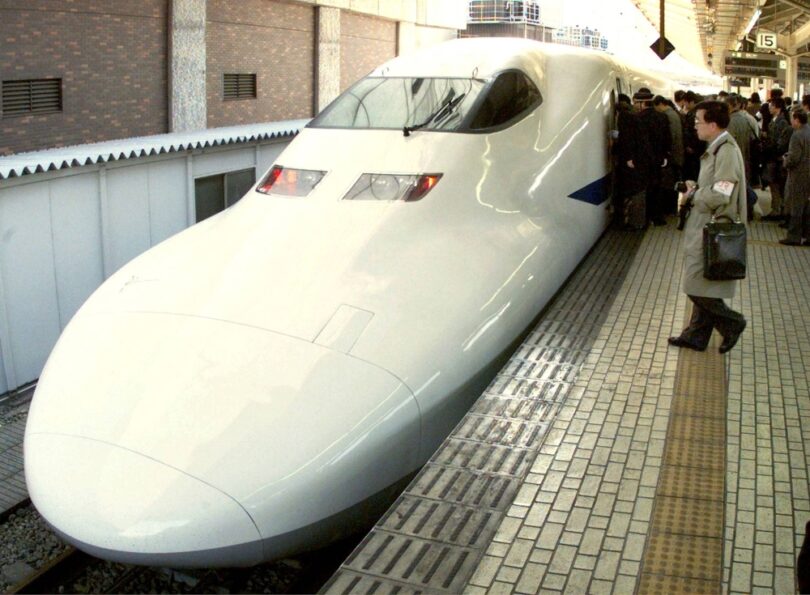Gearoid Reidy
Earlier this summer, U.K. Transport Secretary Mark Harper extolled the virtues of Japan’s bullet train network in a video that has aged even more poorly than most government fluff pieces. “Japan’s rail infrastructure is an exciting vision of what we can do with HS2 – our very own high-speed rail network for the future,” Harper said from a bullet train seat, referring to the project that less than three months later would be radically scaled back. “Building it shows we believe in Britain.”
The U.K. seems to have suffered a crisis of belief, then, with Prime Minister Rishi Sunak last week scrapping the project’s northern leg in favor of a vague initiative for road improvements and nebulous mass transit systems. Though there is indeed much for the U.K. to learn from the safety and punctuality records of bullet trains, if it wants to learn from Japan’s experience in building railways, it’s the value of sticking to a plan. As a project, HS2 was less than 15 years old before Sunak’s announcement derailed it. To be sure, there were notable problems with inflation, budget overruns and ballooning costs. But the place to make those cuts isn’t in overhauling long-term infrastructure objectives.
What the U.K. should copy is Japan’s stick-to-itiveness. Blueprints for the expansion of Japan’s high-speed rail network were laid out in legislation almost exactly 50 years ago in the Nationwide Shinkansen Railway Development Law. It called for the building of five routes on three lines, extending the bullet train (which had opened a decade earlier to link Tokyo and Osaka), as far north as Sapporo and as far south as the bottom tip of Kyushu, as well as connecting Tokyo with a looping route to the Sea of Japan and back to Osaka. Although it’s not yet all complete – notably on the final linking of the Hokuriku Shinkansen to Osaka, which might not be completed until some 75 years after it was first envisioned – a remarkable amount has materialized from the vision put into law in 1973 and featured in then-Prime Minister Kakuei Tanaka’s 1972 book, “Building a New Japan: A Plan for Remodelling the Japanese Archipelago”. Despite 25 different premiers in the half-century since, the country continues to follow that same plan – and the benefits to society from not chopping and changing accrue accordingly. Tanaka was often somewhat unfairly accused of pork-barrel politics for the line that runs to Niigata, his home prefecture, from Tokyo. These days, that route helps shuffle deep-pocketed foreign tourists to the region’s ski and hot spring resorts, tapping a market that barely existed in the 1970s.
For all the not-in-my-back yard sentiment surrounding HS2’s construction, the advantages are clear to British regions that would have been fortunate enough to be near the stations. Japan’s Hokuriku Shinkansen (which uses some of the same track as the Niigata route) has transformed the likes of Nozawa Onsen from an aging ski town to a prime site for foreign investors, following the opening of a nearby bullet train station in 2015. Morioka in northern Iwate Prefecture – ranked second in the world on the New York Times “52 Places to Go in 2023” – would have taken six hours to visit from Tokyo in 1982, before the Tohoku Shinkansen opened. Now it’s a mere two-hour jaunt and will serve as a link in the route that will connect Tokyo and Sapporo early next decade. One estimate put the value of time saved from the shinkansen at ¥500 billion ($3.3 billion) a year. Other studies have shown a marked increase in population, companies locating and tax receipts in cities with a high-speed rail stop, versus those without. There’s no benefit from flip-flopping; instead, the U.K. should tackle the outrageous cost overruns, which led to estimates that the London to Birmingham leg of HS2 would have cost more than twice as much as Japan has allocated for the 500 kilometer-per-hour maglev line that will connect Tokyo and Nagoya later this decade. Despite the initial outlay, one estimate expects a economic impact of ¥10.7 trillion from the maglev after 50 years of operations.
Despite constant doubts that each shinkansen expansion would be a boondoggle usurped by increasingly efficient and cheaper air travel, the bullet train is as healthy than ever – while emitting less than a fifth the carbon dioxide of aircraft. Predictions that the COVID-19 pandemic would wipe it out were far off the mark, with demand recovering nearly to pre-2020 levels during weekdays, while leisure travel has already returned.
It’s no wonder that the US ambassador to Japan, Rahm Emanuel, raves about Japan’s system. To get these projects through the door, however, “what is often needed is a master facilitator willing to expend personal and often political capital to ensure a project’s realization,” analysts from PricewaterhouseCoopers wrote in a 2011 examination of how the shinkansen was built. Safe to say, then, that Sunak, whose government declared that “HS2 is part of the problem and not the solution,” isn’t that person. Japan was fortunate to have Shinji Sogo, the president of what was then Japanese National Railways, and Hideo Shima, the shinkansen’s chief engineer. When the original bullet train joined Tokyo and Osaka just days before the opening of the 1964 Tokyo Olympic Games, neither were there to celebrate, having resigned to take responsibility for budget overruns that came to nearly twice that of initial estimates. But who now thinks the government should have pulled the project (perhaps declaring, to channel Sunak, a “Network Nagoya” of strategies to boost regional roads and buses)?
Not everything has worked out according to the 1973 outline – a planned shinkansen to link Tokyo and the distant Narita Airport never materialized due to what might now be termed “NIMBYism.” Other routes only sketched out in the original plans for less densely populated areas such as Shikoku seem unlikely to ever leave the drawing board. The Hokkaido Shinkansen currently suffers from very low ridership, as it has yet to link Tokyo and Sapporo, which won’t happen until early in the 2030s. Last week, as I traveled along the Kyushu Shinkansen – a route entirely new to me that joins Kagoshima and Fukuoka, or about the same distance as London and Sheffield – in a little over an hour, it was hard to believe high-speed rail can be “part of the problem.” These generational projects can only come from the coordination of strong national and local governments together with private industry – the very job of leadership to promote, not vacillate over. Next year, with HS2’s London to Birmingham route still years from operation, Japan’s shinkansen will celebrate its 60th anniversary. Ironically, for something famed for its swiftness, when it comes to high-speed rail, slow and steady wins the race.
The Japan Times







